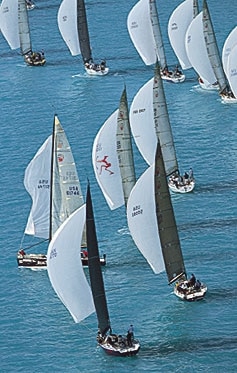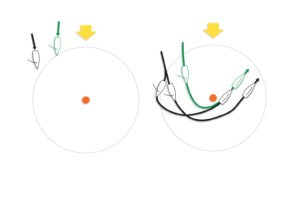
MMT-April
The first jibe after rounding the top mark is always a tough call. When I look at Real Tick’s situation in our photo sequence, here’s what comes to mind:
Hopefully, these guys have tuned into the traffic report for the upwind starboard-tack layline. In any large fleet, be it Farr 40s, Melges 24s, or Stars, jibing underneath the starboard-tack layline rarely pays, primarily because of the bad air and disturbed from boats coming upwind. In Real Tick’s case, there’d better be more pressure on the other jibe, or at least a line of pressure moving across the course, for its move to pay off.
If Real Tick wallows in dirty air for more than four boatlengths, it will negate any gain they make if they’re first to the new wind or shift. If Real Tick jibes and sails to a grinding halt, the boats ahead will simply go the extra four or five lengths, jibe, and will likely be lower and faster while getting their breeze from behind Real Tick’s windshadow. The crew on Real Tick should be looking at the downwind traffic as well, and have a good idea of what’s going on with any boats behind.
In Photo 1, we can see Real Tick’s crew setting up for the jibe, which will telegraph to the boats behind that they’re jibing. That’s real risky for Real Tick. In this situation, they want their jibe to be as much of a surprise as possible. The last thing Real Tick wants is for a competitor behind to match its jibe, forcing Real Tick to sail extra distance to keep its air clear. Coupled with potential bad air from the starboard tack layline, this could be a losing move? big time. Few things are worse than jibing away from a pack only to have the boat behind jibe simultaneously. When this happens, you have to reach up to clear your air, and you give away a ton of distance.
The one thing I do like about Real Tick’s position before the jibe is they’re positioned well with the pack ahead. If everybody in front jibed simultaneously with Real Tick, Real Tick would come out strong. Considering the relative positions of the boats in Photo 1, Real Tick would roll the boat that’s immediately ahead. More importantly, Real Tick would have clean air?assuming no boats behind jibed?and thus be able to sail its desired angle. What happens to Real Tick later on in the leg? Luckily, I witnessed this scenario and my recollection of Real Tick’s move was that it played out well. The boat I was on was just ahead of the pack, sailing into the right-hand corner [looking downwind]. Real Tick made it across on port jibe without a competitor jibing on its breeze, gained in the increased pressure and shift, and passed the entire group they rounded with?excellent move. The risk/reward is high in this situation, but tactically, the keys to pulling it off will be to keep the crew from announcing their intentions and getting a jump on the competition behind. As I learned later in the leg, getting out on your own and being able to sail the best VMG without traffic is always a winning move.
For more of Cheryll Kerr’s photos from Terra Nova Trading Key West Race Week, and other Grand-Prix events, go to http://www.regattaphotos.com









